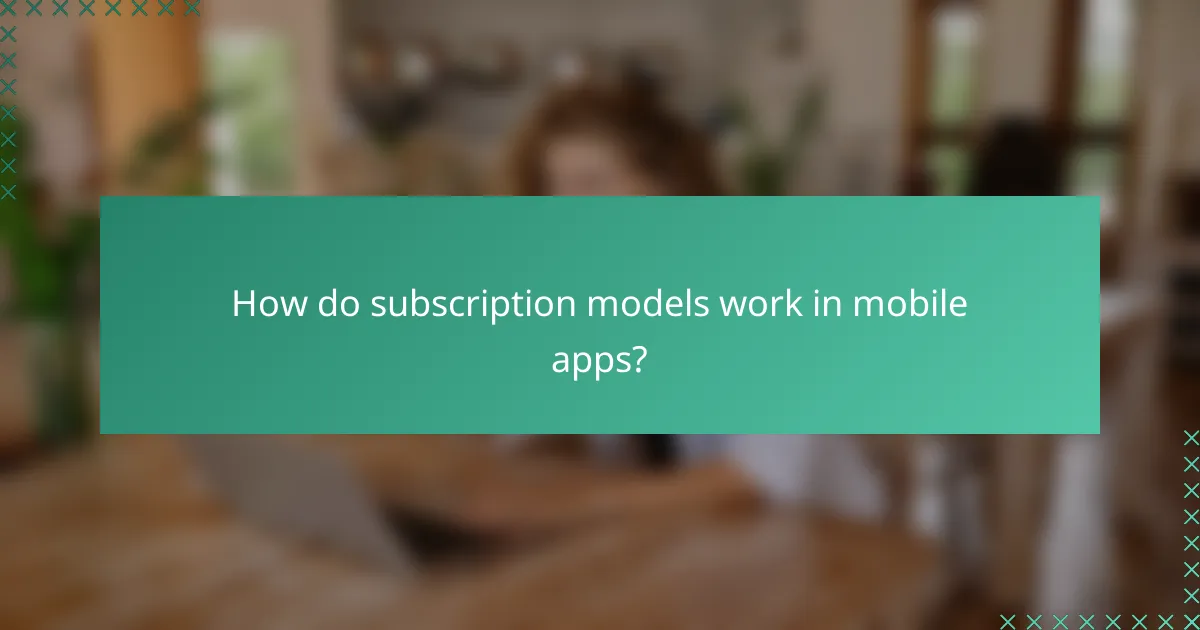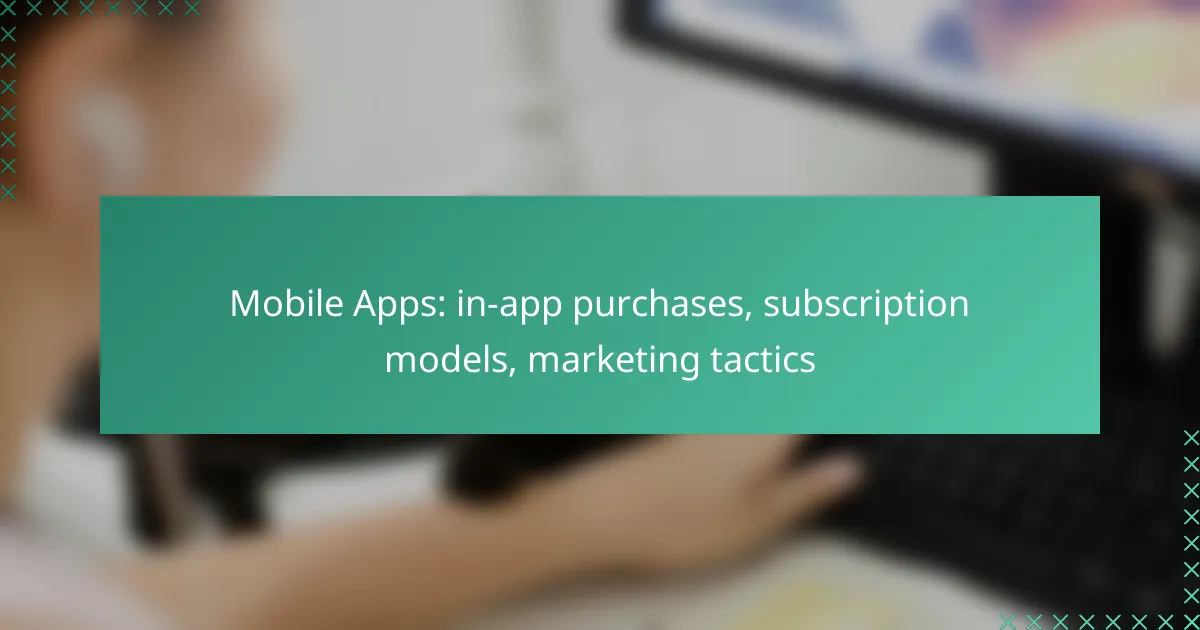Mobile apps increasingly rely on in-app purchases and subscription models to drive revenue while enhancing user experience. By implementing strategies such as the freemium model and limited-time offers, developers can effectively monetize their apps. Additionally, employing targeted marketing tactics like App Store Optimization and social media advertising can significantly boost app visibility and user engagement.

What are effective in-app purchase strategies for mobile apps?
Effective in-app purchase strategies involve offering users compelling options that enhance their experience while maximizing revenue. Key approaches include the freemium model, consumable purchases, subscription tiers, limited-time offers, and in-game currency.
Freemium model
The freemium model allows users to access a basic version of the app for free, with the option to purchase premium features. This strategy attracts a larger user base while converting a percentage of them into paying customers. It’s crucial to balance free content with enticing paid features to encourage upgrades.
Consider offering a trial period for premium features, which can increase conversion rates. A common practice is to provide a limited set of features for free, while more advanced functionalities require payment.
Consumable purchases
Consumable purchases are items that users buy and use up, such as extra lives in a game or virtual goods. This strategy encourages repeat purchases, as users will need to buy more once they exhaust their initial supply. It’s effective in games and apps that rely on ongoing engagement.
To optimize this approach, ensure that consumables provide a clear benefit to the user experience. For example, pricing should be reasonable, and users should feel that their purchases enhance gameplay or functionality significantly.
Subscription tiers
Subscription tiers offer users different levels of access based on their payment. This model can provide a steady revenue stream and allows users to choose a plan that fits their needs, such as monthly or annual subscriptions. It’s essential to clearly communicate the benefits of each tier to encourage upgrades.
Consider offering a free trial for higher tiers to showcase the added value. Pricing should reflect the features offered, and it’s beneficial to analyze competitors’ subscription models to remain competitive in the market.
Limited-time offers
Limited-time offers create urgency, encouraging users to make purchases before the deal expires. This strategy can be particularly effective during holidays or special events, driving sales and increasing user engagement. Highlighting the time-sensitive nature of these offers can boost conversion rates.
When implementing limited-time offers, ensure that they are genuinely valuable to users. Discounts on popular items or exclusive content can motivate users to act quickly, enhancing the overall effectiveness of the campaign.
In-game currency
In-game currency allows users to purchase virtual goods or services within the app, creating an engaging economy. Users can earn currency through gameplay or buy it directly, which can lead to increased spending. It’s important to maintain a balance so that users feel rewarded for their efforts without feeling pressured to spend.
Implementing a tiered currency system can enhance user experience, where different currencies can be earned or purchased at varying rates. This adds depth to the app’s economy and encourages users to engage more with the app to earn currency through gameplay.

How do subscription models work in mobile apps?
Subscription models in mobile apps allow users to access content or features for a recurring fee, typically charged monthly or annually. This model provides developers with a steady revenue stream while offering users ongoing value through updates and new content.
Monthly subscriptions
Monthly subscriptions require users to pay a fee every month to maintain access to the app’s features or content. This model is popular for services that frequently update their offerings, such as streaming platforms or fitness apps. Users appreciate the flexibility of canceling at any time, but developers must ensure consistent value to retain subscribers.
Annual subscriptions
Annual subscriptions involve a one-time payment for a full year of access, often at a discounted rate compared to monthly payments. This model can enhance user commitment, as subscribers are less likely to cancel mid-year. Developers may incentivize annual subscriptions with exclusive content or lower overall costs, making it appealing for long-term users.
Free trial periods
Free trial periods allow users to experience the app’s features without payment for a limited time, usually ranging from a week to a month. This tactic can effectively convert users into paying subscribers, as it provides a risk-free opportunity to evaluate the app’s value. However, developers should clearly communicate when the trial ends to avoid unexpected charges.
Content access
Content access in subscription models typically includes exclusive features, premium content, or ad-free experiences. Users expect regular updates and new offerings to justify their ongoing payments. Developers should consider tiered access levels to cater to different user needs, allowing for a broader audience while maximizing revenue potential.

What marketing tactics boost mobile app visibility?
Effective marketing tactics for enhancing mobile app visibility include App Store Optimization (ASO), social media advertising, influencer partnerships, and email marketing campaigns. These strategies help increase downloads and user engagement by targeting the right audience and improving discoverability.
App Store Optimization (ASO)
App Store Optimization (ASO) is the process of improving your app’s visibility in app stores like Google Play and Apple App Store. Key elements include optimizing your app title, keywords, description, and visuals to rank higher in search results.
Consider conducting keyword research to identify terms potential users are searching for. Regularly updating your app’s metadata based on performance analytics can also help maintain or improve its ranking.
Social media advertising
Social media advertising involves promoting your app through platforms like Facebook, Instagram, and Twitter to reach a broader audience. Targeted ads can be tailored based on user demographics, interests, and behaviors, ensuring that your marketing efforts are efficient.
Utilize eye-catching visuals and compelling calls-to-action in your ads. Setting a budget and testing different ad formats can help identify what resonates best with your audience, optimizing your return on investment.
Influencer partnerships
Influencer partnerships leverage the reach and credibility of social media influencers to promote your app. Collaborating with influencers who align with your app’s target audience can enhance trust and drive downloads.
Choose influencers based on their engagement rates and relevance to your niche. Providing them with exclusive access or incentives can encourage authentic promotion, making their endorsements more effective.
Email marketing campaigns
Email marketing campaigns can effectively engage potential users and keep existing ones informed about updates or promotions. Building a targeted email list allows you to send personalized messages that resonate with your audience.
Segment your audience based on their behavior or preferences to tailor your content. Regularly analyzing open and click-through rates can help refine your strategy for better results, ensuring your campaigns remain impactful.

What criteria should be considered when choosing a monetization model?
Choosing a monetization model for a mobile app requires careful consideration of several criteria, including target audience demographics, market competition, and user engagement metrics. Each of these factors can significantly influence the effectiveness and profitability of the chosen approach.
Target audience demographics
Understanding the demographics of your target audience is crucial for selecting an appropriate monetization model. Factors such as age, income level, and geographic location can dictate whether users are more likely to respond to in-app purchases or subscription services.
For example, younger audiences may prefer free-to-play models with in-app purchases, while older users might be more inclined to pay for a subscription that offers premium content. Tailoring your approach to the specific characteristics of your audience can enhance revenue potential.
Market competition analysis
Analyzing the competition in your app’s market is essential for determining the best monetization strategy. Researching similar apps can provide insights into which models are successful and which are not. Look for trends in pricing, user reviews, and overall revenue generation.
For instance, if competitors are predominantly using subscription models and achieving high retention rates, it may be beneficial to consider a similar approach. Conversely, if most apps in your niche rely on one-time purchases, that might indicate a different user expectation.
User engagement metrics
User engagement metrics are vital for assessing how well your app retains users and encourages spending. Metrics such as daily active users (DAU), session length, and churn rate can inform your monetization decisions. High engagement often correlates with a greater willingness to spend.
For example, if your app shows strong engagement but a high churn rate, a subscription model might help retain users by providing ongoing value. Conversely, if users are less engaged, focusing on one-time purchases or limited-time offers could drive immediate revenue without the commitment of a subscription.

What are the emerging trends in mobile app monetization?
Emerging trends in mobile app monetization focus on innovative strategies that enhance user engagement and revenue generation. Key trends include personalized user experiences, subscription models, and effective marketing tactics that cater to user preferences and behaviors.
Personalized user experiences
Personalized user experiences are crucial for maximizing user engagement and retention in mobile apps. By leveraging data analytics and user behavior insights, developers can tailor content, recommendations, and offers to individual users, making the app more relevant and enjoyable.
For instance, apps can use machine learning algorithms to analyze user interactions and suggest features or products that align with their interests. This approach not only enhances user satisfaction but can also lead to higher conversion rates for in-app purchases and subscriptions.
To implement personalized experiences effectively, consider segmenting your user base and testing different personalization strategies. Avoid overwhelming users with too many options; instead, focus on a few key features that resonate with their preferences.
